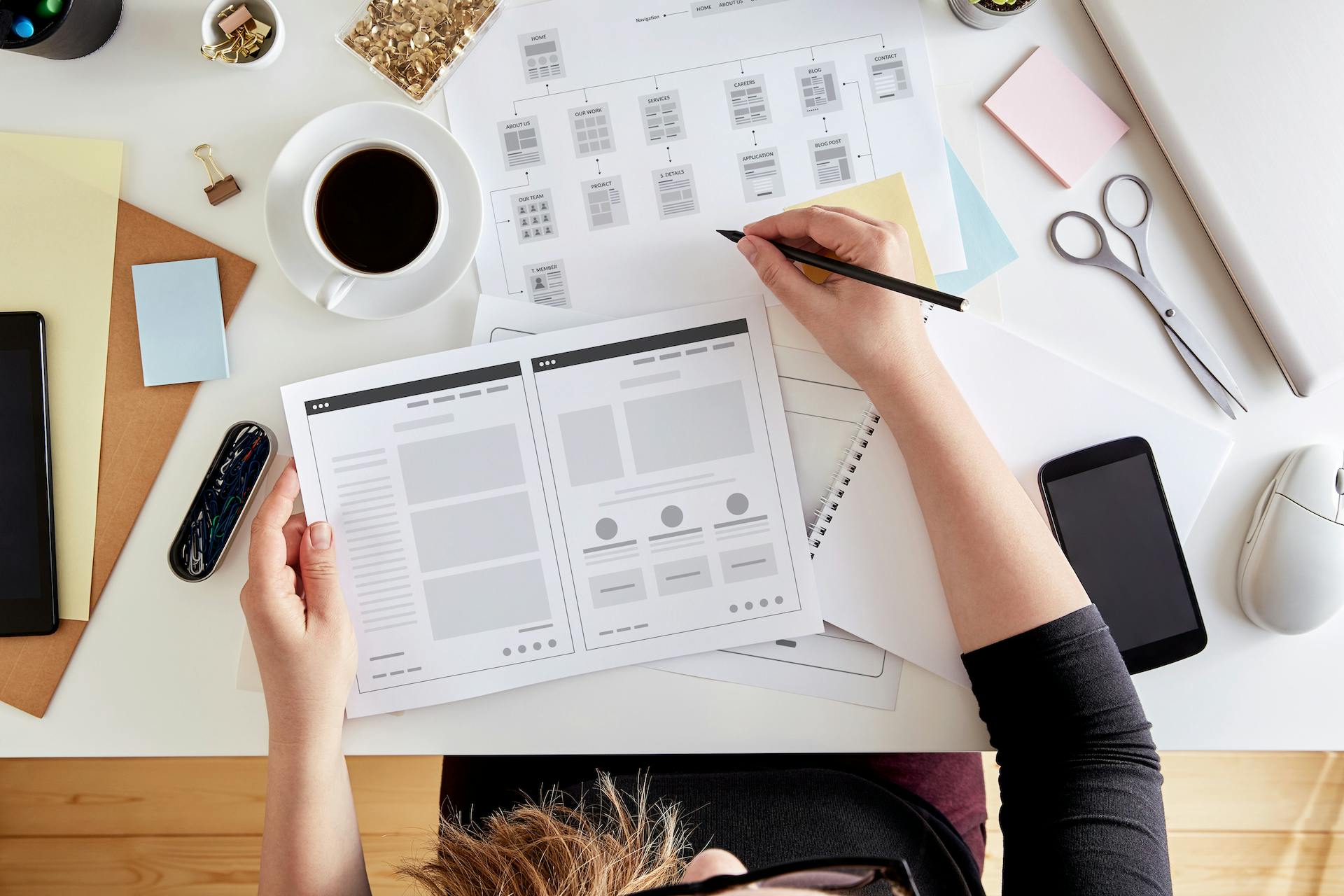Imagine you are visiting a website for the first time. You want to find information, buy a product, or sign up for a service. How do you feel when the website is easy to use, fast to load, and visually appealing? How do you feel when the website is confusing, slow, and ugly? These feelings are influenced by the UX/UI design of the website.
From boosting user engagement to enhancing brand credibility, the impact of a well-crafted user experience and interface cannot be overstated. So, fasten your seatbelts as we unravel the myriad benefits and explore how you can leverage UX/UI design to take your website to the modern age.
Understanding UX/UI Design Fundamentals
The Distinction Between UX and UI
While often mentioned together, UX (User Experience) and UI (User Interface) serve distinct but complementary roles in website design:
- User Experience (UX) focuses on the overall journey and interaction between users and your website
- User Interface (UI) deals with the visual elements and interactive components that facilitate this journey
The Psychology Behind Effective Design
Research from the Nielsen Norman Group shows that users form opinions about websites within 0.05 seconds of viewing them. This first impression is crucial for:
- Establishing credibility
- Building trust
- Encouraging further exploration
- Converting visitors into customers

Real-World Success Stories
Airbnb's UX Revolution
In 2014, Airbnb underwent a major ux website redesign that transformed their business. Key improvements included:
- Simplified booking process
- Enhanced photo displays
- Improved search functionality
- Mobile-first approach
The result? A 30% increase in bookings and a 40% decrease in bounce rates within the first year after implementation.
Apple's Homepage UX Evolution
Apple's website serves as a benchmark for successful UI implementation. Their approach to homepage UX emphasizes:
- Minimalist design
- Strong visual hierarchy
- Intuitive navigation
- Emotional connection through imagery
This strategy has contributed to their consistent ranking as one of the world's most valuable brands, with their website converting visitors at rates 2-3 times higher than industry averages.
Additional Case Studies
Case Study 1: Spotify's Desktop Redesign
When Spotify decided to evaluate website UI intuitiveness in 2020, they discovered several pain points in their desktop application. Their comprehensive redesign focused on:
- Simplified Navigation
- Reduced menu options from 27 to 12
- Implemented a more logical grouping system
- Added keyboard shortcuts
- Enhanced Discovery Features
- Improved recommendation algorithms
- Created more visible playlist suggestions
- Added related artists section
- Results
- 32% increase in user engagement
- 45% improvement in playlist creation
- 25% reduction in support tickets
Case Study 2: Duolingo's Gamification Success
Duolingo's approach to web design for long term success through gamification has become a blueprint for educational platforms:
- Implementation Strategy
- Progress visualization
- Achievement system
- Social competition elements
- Streak maintenance rewards
- Measured Outcomes
- 50% increase in daily active users
- 68% improvement in lesson completion rates
- 85% user retention after 12 months
Essential Elements of Successful UI
1. Visual Hierarchy
Research by the University of Basel shows that proper visual hierarchy can improve information retention by up to 78%. Key principles include:
- Size variation
- Color contrast
- White space utilization
- Typography hierarchy
2. Navigation Design
A study by HubSpot revealed that 76% of consumers say the most important factor in website design is "ease of finding information." Essential navigation elements include:
- Clear menu structure
- Breadcrumb trails
- Search functionality
- Mobile responsiveness
Think of UX/UI design as the choreographer of your online presence, orchestrating a seamless dance between your visitors and your website. The user experience focuses on understanding your audience's needs, desires, and behaviors.
3. Loading Speed
Google's research indicates that 53% of mobile users abandon sites that take longer than 3 seconds to load. Optimization techniques include:
- Image compression
- Code minification
- Browser caching
- Content delivery networks
Measuring and Improving UX Performance
Key Performance Indicators (KPIs)
To effectively evaluate website UI intuitiveness, track these essential metrics:
- Engagement Metrics
- Time on page
- Pages per session
- Bounce rate
- Scroll depth
- Conversion Metrics
- Conversion rate
- Cart abandonment rate
- Form completion rate
- Click-through rate
User Testing Methods
- A/B Testing
- Split testing different designs
- Measuring performance differences
- Iterative improvements
- Heatmap Analysis
- Click tracking
- Scroll mapping
- Mouse movement analysis
- User Surveys
- Net Promoter Score (NPS)
- Customer Effort Score (CES)
- System Usability Scale (SUS)
According to a study by Forester, good UI can raise a website’s conversion rate by up to 200%, while a better UX design can raise the conversion rate by up to 400%. UX/UI design can also affect the performance and efficiency of a website. Furthermore, Every 100ms decrease in homepage load speed worked out to a 1.11% increase in session-based conversion, yielding an average annual revenue increase of nearly $380,000.
Interactive Learning Resources
UX/UI Design Quiz
Test your knowledge with these essential questions:
- What is the primary difference between UX and UI design?
- How does visual hierarchy impact user behavior?
- What are the key elements of successful navigation design?
- How can loading speed affect user experience?
[Interactive quiz removed for markdown format - implement as desired]
Design Comparison Tool
Experience the difference between good and bad design choices:
- Color Contrast Examples
- Typography Combinations
- Layout Variations
- Navigation Patterns
[Interactive tool removed for markdown format - implement as desired]
Future Trends in UX/UI Design
Emerging Technologies
- Voice User Interface (VUI)
- Integration with traditional interfaces
- Natural language processing
- Voice-activated navigation
- Augmented Reality (AR)
- Interactive product visualization
- Virtual try-ons
- Spatial computing
- Artificial Intelligence
- Personalized user experiences
- Predictive interfaces
- Automated testing and optimization

A good UX/UI design can also help avoid usability issues and errors that might require fixing later. The development process can be more efficient and cost-effective by testing and validating the design with users early and often. It can also create a positive impression and trust among users, which can boost the brand’s reputation and credibility. According to a study by Adobe, 38% of people will stop engaging with a website if the content or layout is unattractive.
Design Evolution
- Microinteractions
- Subtle animations
- Feedback mechanisms
- Status indicators
- Dark Mode
- Reduced eye strain
- Energy efficiency
- Aesthetic appeal
- Accessibility Focus
- WCAG 2.2 compliance
- Inclusive design
- Universal accessibility
Conclusion
The success of your website depends heavily on the quality of its UX/UI design. By focusing on homepage UX, implementing web design for long term success, and regularly evaluating website UI intuitiveness, you can create a digital presence that not only attracts users but converts them into loyal customers.
Remember that successful UI is an ongoing process of improvement and adaptation. Stay current with emerging trends, continuously gather user feedback, and be willing to evolve your design approach based on data-driven insights.

